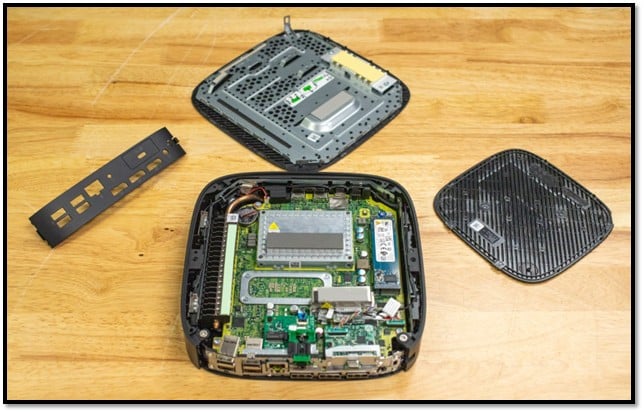In a recent article, I was surprised by how well a Raspberry Pi 500, an inexpensive computer running Stratodesk NoTouch OS, performed as a thin client. By coincidence, I recently had the opportunity to write a review for StorageReview.com on HP’s newest top-of-the-line thin client, the HP t660, which also runs NoTouch OS.
I thought it would be interesting to compare and contrast these two systems.
Two Different Devices
Don’t be fooled by the photo below. This is not a computer AND a keyboard – it is two thin clients as the keyboard has a computer inside it.

Although both thin clients are attractive, I will refer to the Pi 500 as the beauty in this article because I was struck by the elegance of the keyboard that houses the computer.
The computer inside the Pi 500 is based on Raspberry’s wildly popular Pi 5. It has a four-core Arm processor, 8 GB of RAM, and 128 GB of persistent storage. In my previous article, I proved that running Stratodesk NoTouch OS was capable of handling the day-to-day tasks of task workers.

On the other hand, the HP t660m is definitely a beast of a thin client. It is powered by an Intel processor with five cores, up to 32GB of DDR5 RAM, and 512GB NVMe storage. HP claims that this hardware stack enables it to deliver 58% more performance than its last generation.
The power of the HP system comes at a price: The T660 costs around $650, while the Pi costs less than $100.

Here is a table that compares the hardware of the Raspberry Pi 5 and HP t660 Thin Client
The two systems only have one thing in common: they can run Stratodesk NoTouch OS.
CPU Comparison
As the CPU is the heart of the systems, let’s compare the Intel processor in the t660 to the Arm processor in the Pi system.
CPU benchmark shows that the Intel U300e processor in the t660 is more than three times as performant as the Arm Cortex-A76 processor found in the Pi 500.

As many processes are single-threaded, I found the single-thread rating more interesting. It shows that the cores in the A76 were only one-third as performant.

I need to put an asterisk on this. The U300E has one performance core and four efficiency cores. I believe that the single-thread test probably ran on the performance core.
I want to get a bit geeky: the performance core in the U300E processor is a 1.10 GHz (4.30 GHz turbo) Raptor Cove CPU, while the four efficiency cores are 0.80 GHz (3.20 GHz turbo) Gracemont CPUs. A CPU with both performance and efficiency cores allows for a better balance between raw processing power for demanding tasks and energy efficiency for lighter workloads. This approach provides the best of both worlds by dedicating high-performance cores to intensive applications while utilizing lower-power cores for background processes, thereby maximizing overall system efficiency and power usage.
Think of the performance cores as a 1977 Pontiac Trans Am and the efficiency cores as a Toyota Prius. If you’re The Bandit racing from Texarkana, Texas, to Atlanta, Georgia, while evading the smokies, you’ll want the Trans Am. However, the Prius is the better option for celebrities commuting from their homes in Brentwood to their jobs in Hollywood.

GPU Comparison
Several key differences emerge when comparing the VideoCore VII GPU found in the Raspberry Pi 500 to the Embedded Intel UHD Graphics for 13th-generation Intel Processors. The VideoCore VII, integrated into the Pi’s Arm-based architecture, is designed with efficiency and power consumption in mind, making it suitable for lightweight graphical tasks, multimedia playback, and basic gaming on low-power devices.
In contrast, Intel UHD Graphics benefits from higher overall performance capabilities. This GPU is optimized for various uses, from casual gaming to multimedia creation, offering support for higher resolutions, faster rendering times, and improved performance in multi-threaded applications.
Memory Comparison
Although the LPDDR4X RAM used in the Pi 500 and the DDR5-5200 used in the t660 are both DRAM memory, they are optimized for different use cases.
LPDDR4X memory is designed for low power consumption, making it ideal for mobile devices, which offer speeds of up to 4267 MT/s. It consumes less energy due to lower operating voltage, which helps extend battery life. In contrast, DDR5-5200 is designed for higher-performance computing, such as desktops and servers. It operates at higher speeds (5200 MT/s), supports larger memory capacities, and improves bandwidth, but DDR5 consumes more power than LPDDR4X.
Persistent Storage Comparison
The two devices use different types of persistent storage. The Pi 500 utilizes the new SDR104 interface for MicroSD cards, which is part of the UHS-I (Ultra High-Speed) standard. It offers data transfer rates of up to 104 MB/s and up to 5,000 read IOPS and 2,000 write IOPS. It was designed for devices that need faster read and write speeds compared to older MicroSD standards. MicroSD cards are commonly used in video cameras, as well as in mobile and embedded devices.
In contrast, the NVMe drive utilizes PCIe lanes and offers extremely fast read and write speeds, reaching several Gigabytes per Second. They are designed for high-performance tasks such as gaming, video editing, and server applications. NVMe drives offer higher capacity and lower latency compared to MicroSD.
Installing Stratodesk NoTouch OS
Hardware is useless without an operating system. Stratodesk NoTouch OS stands out as a thin client OS due to its exceptional optimization for VDI, DaaS, and streaming applications. From its beginning, it was designed to be lightweight yet powerful, ensuring smooth performance even on hardware with limited computing resources. One of the key strengths of NoTouch OS is its ability to maximize the potential of both high-end and budget-friendly devices, enabling users to achieve efficient and reliable performance across diverse environments.
Stratodesk provides comprehensive documentation and detailed guides that help users navigate the setup and optimization processes of NoTouch OS. I downloaded the free NoTouch trial and installed it without any issues.
For the t660, I wrote the x64 ISO to a thumb drive using Rufus, booted off the thumb drive, and installed it on the NVMe drive.
For the Pi, I used Rufus to burn the lnx-3.6.527-EEs-k606-arm64-241216.bin file to a MicroSD card, and then I installed it from the same MicroSD card.
It took me less than 5 minutes to install NoTouch OS on each device.
Stratodesk’s regular software updates ensure that the OS remains secure and up-to-date with the latest features and improvements, which is vital for maintaining system stability and performance. Updates, as well as other monitoring and management functions, can be done painlessly using Stratodesk NoTouch Center or NoTouch Center Cloud.
If I had experienced any issues with NoTouch OS, I could have contacted Stratodesk’s technical support via email or phone for troubleshooting advice and technical solutions. Stratodesk also has an active user community that provides a platform for sharing experiences, seeking help, getting tips from other users, and fostering a collaborative environment.
For businesses, Stratodesk offers personalized assistance through dedicated account managers who provide tailored support solutions, including custom development and training services. This level of support ensures that enterprise clients can fully leverage the capabilities of NoTouch OS to meet their specific needs.
Support Matters
Support is often a deciding factor when buying hardware and software, especially with larger companies.
HP has a well-respected support organization that is known for its global reach. This includes technical account managers who provide dedicated assistance for HP hardware. The company’s support infrastructure is comprehensive, catering to both individual consumers and large enterprises, offering troubleshooting, warranty services, and extended support plans.
The Raspberry Pi systems have multiple support options. The Raspberry Pi Foundation provides comprehensive documentation, including step-by-step guides, troubleshooting tips, and detailed explanations of features. Many people find the Raspberry Pi forums a valuable resource for asking questions, sharing projects, and getting help from other users who are almost rabid in their devotion to helping others.
Various third-party providers offer professional services, such as technical support, custom development, and training, for Pi systems.
Does Hardware Matter
On paper, it would appear that the t660 hardware would leave the Pi 500 in the dust, but NoTouch OS has been highly optimized for VDI, DaaS, and streaming applications and, as such, doesn’t use as many computing resources as you would expect. So, although the t660 is far more powerful on paper than the Pi, its advantage may not be significant in the real world, depending on the types of users and their specific use cases.
In my next article, I will use these two devices under various workloads to see how well they perform under different conditions.


